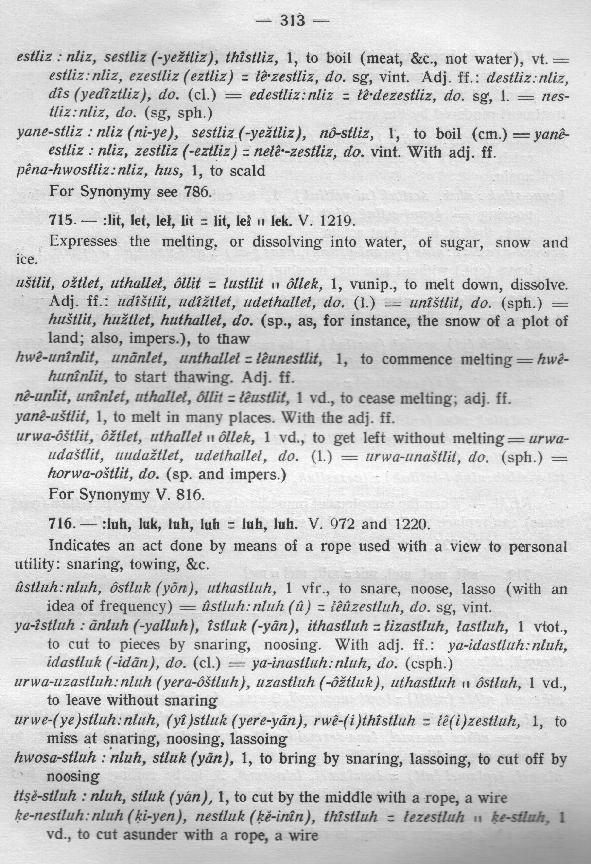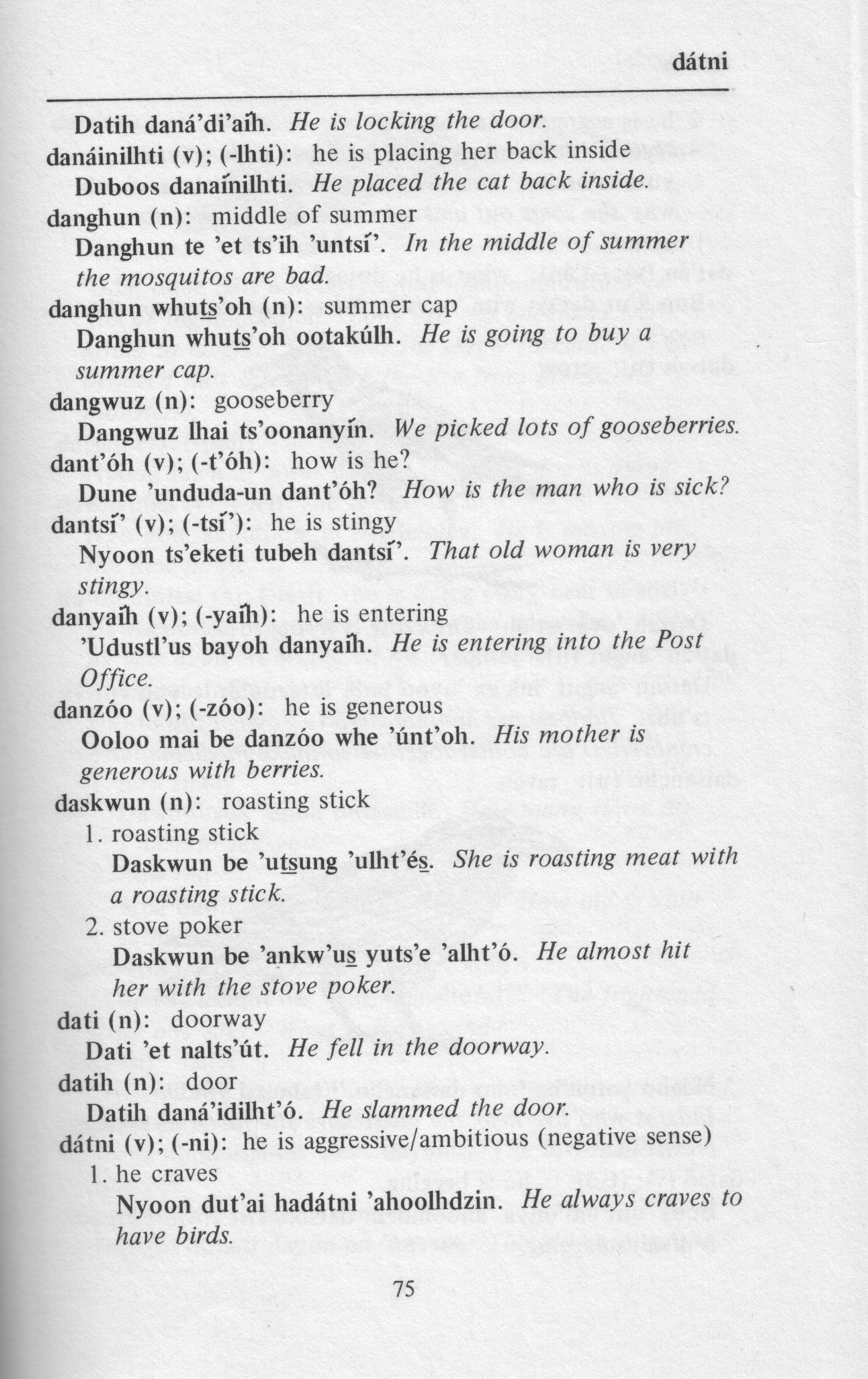
The information in this dictionary comes from a variety of sources. Much of it comes from my own work with Carrier speakers, most extensively the late Robert Hanson and the late Russell Alec, and more recently Charlie Joseph, but including many others. Some of it comes from the study of stories and other written material. Four major sources are two previous dictionaries, some unpublished field notes, and a set of unpublished audio recordings.
The earliest and most copious source is Father Adrien-Gabriel Morice's two-volume book The Carrier Language, published in 1932, the result of residence in the territory from 1885 to 1904 followed by many years of study and correspondence with Carrier speakers, especially Louis-Billy Prince. This book is not organized like an ordinary dictionary but contains several tens of thousands of Carrier words, the majority of which are in this dictionary.
Whenever an entry has Morice's book as a source, among the abbreviations for the sources at bottom right will be one consisting of "MO" immediately followed by the number of the section in which it is mentioned. Clicking on such a field will open an image of the page in another tab.
For example, this entry shows "MO970" as its source.

Clicking on "MO970" opens this image page in another tab.

Buttons at the bottom of the image page allow you to navigate to the preceding and following pages.

Material from Morice has been phonemicized and transliterated into the Carrier Linguistic Committee writing system from the idiosyncratic subphonemic system that he used. (For an explanation of his writing system for those familiar with the CLC system see Understanding How Father Morice Wrote Carrier.) It has also been modernized in certain respects. That is, regular sound changes that took place between Morice's time and the present have been implemented. The most important of these is the change from ukh to oh. For example, the word “house” used to be pronounced yukh (in Morice's writing system yerh) but is now pronounced yoh. Whenever Morice wrote erh, we have written oh.
Other types of historical change have not been made. For example, in Morice's time the third person duo-plural subject marker h was often followed by an epenthetic u even when it preceded a consonant and was preceded by another u, as in nuhutikelh “they will go around in a boat”. At present, rather than inserting an epenthetic u, the h is allowed to become the coda of the syllable and to undergo the rule of UH-Fusion, whereby the sequence u - coda h fuses into o. The modern form of “they will go around in a boat” is therefore notikelh. This change was evidently gradual. Some contracted forms with o are found fairly early, while at present, although the contracted forms are usual, from time to time one still encounters an uncontracted form in uhu, and a few speakers systematically use the uncontracted forms. The uncontracted forms written by Morice are given as such.
Morice was aware of the distinction between the “fronted” (lamino-dental) consonants s, z, ts, dz, and ts' and their ordinary (apico-alveolar) counterparts s, z, ts, dz, and ts' but frequently failed to write it. Where morphemes are identifiable and are known to be fronted, marking of fronting has been added. Similarly, although Morice was aware of the glottal stop, in practice he often missed it. Where glottal stops can be restored with confidence, I have done so.

The next source is a set of field notes compiled by the late Robert Young (1912-2007) in 1939 as edited in 1974. Young is best known as an expert on Navajo, particularly as the co-author, with William Morgan, of The Navajo Language: a Grammar and Colloquial Dictionary. What is not so well known is that as a young man in 1939 Young accompanied John Peabody Harrington on a tour of the Athabascan languages of Canada. The two spent three weeks of December 1939 in Fort St. James, where Young worked with one of the three sons of Louis-Billy Prince. Which of the three is not known with certainty but it was most likely John. Young elicited over 5,000 verb forms, in most cases in the form of extensive paradigms, together with a modest amount of other vocabulary. Young wrote in a modified version of the writing system used at the time for Navajo, which was sufficient to record the sounds of Carrier. Like Morice's, his writing system is subphonemic. Young's material has been phonemicized and transliterated into the Carrier Linguistic Committee writing system.
Young had a good ear and was generally accurate in his transcription. He was already sufficiently familiar with Navajo, after four years' study, to have a good idea of what to look for in Carrier, that is, what the various forms of the verb are and what distinctions might be made. His terminology reflects the grammar of Navajo and is not always ideal for Carrier, but it is clear what he meant.
Young's glosses are primarily in English, but he also made use of Spanish for meanings that might be considered vulgar and occasionally when he evidently felt that the meaning of the Carrier form was more concisely expressed in Spanish. I have translated his Spanish glosses into English.
Here is a sample page of Young's notes.

The material collected by Harrington has not yet been incorporated into this dictionary.
The third source is the Central Carrier Bilingual Dictionary published by the Carrier Linguistic Committee in 1974, compiled by Francesca Antoine, Catherine Bird, Agnes Isaac, Nellie Prince, Sally Sam, Richard Walker, and David B. Wilkinson. It contains a little over 3000 entries, each with an example sentence. The present dictionary includes all of the the entries in this dictionary, in some cases with corrections or presented differently.

The dictionary also contains material collected in 1975-1976 by Dr. Eung-Do "Ed" Cook, then of the University of Calgary, from several speakers. These take the form of audio recordings, housed in the Royal British Columbia Museum and the University of Calgary archives, of word lists, sets of verb forms, and a conversation between two speakers. This is the source of all of the material from Minnie Louie (née Sam) and much of the material from Walter Joseph, Sr., Bernadette Rossetti, and Rose Pierre. In these cases, the transcription of the material is my own.